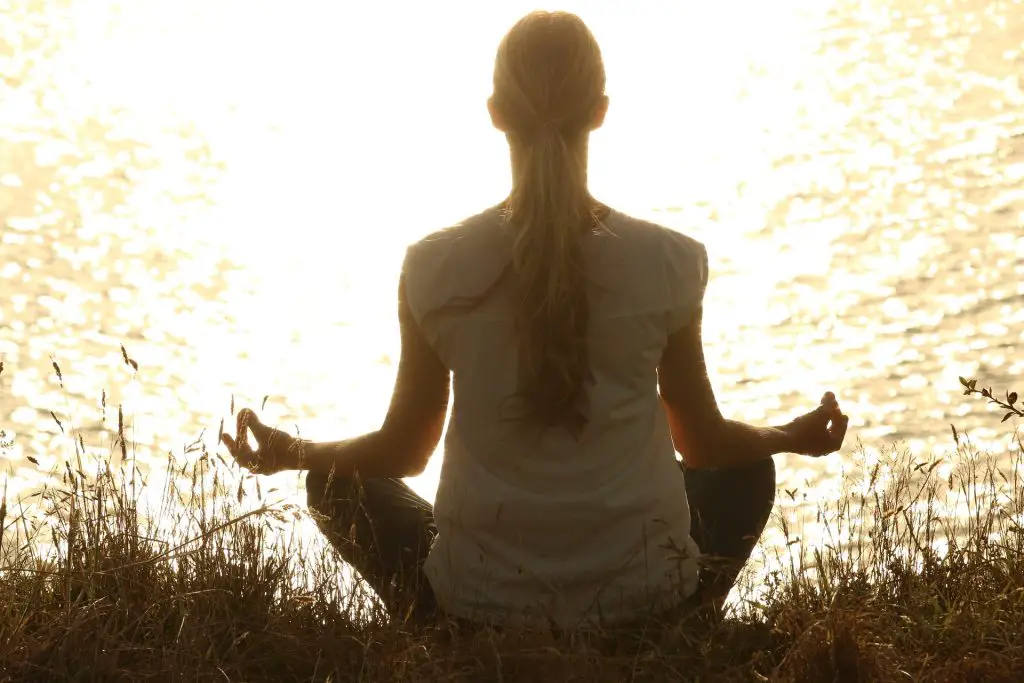Hara meditation is an ancient practice focusing on the sacral energy center located in the pelvic region. This technique emphasizes the balance and activation of the hara chakra, a vital energy hub recognized for its potential to empower, heal, and inspire individuals. By visualizing an amber glow within this area during meditation, practitioners can unlock the many benefits tied to this essential energy center.
Within the Rinzai Zen tradition, hara breathing is cultivated through prolonged zazen practice or seated meditation. As individuals deepen and slow their breath, they develop enhanced proprioceptive awareness of their lower abdomen [1]. Hailing from Japan, the term ‘hara’ refers to a point about two finger widths below the navel, considered a major center of ki, or life energy. Connecting with this point through meditation brings balance and stability to both martial arts and daily life experiences [2].

Whether you are seeking personal growth, healing, or deeper self-awareness, hara meditation offers a unique approach by concentrating on the vital energy linked to the sacral region. As practitioners incorporate this method into their wellness routines and mindfulness practices, they can experience transformative effects on their mental, emotional, and physical well-being.
Hara Meditation: Basics and Importance
Fundamental Concepts
Hara meditation is a practice that focuses on the hara, an energy center situated approximately two inches below the navel. This energy center is believed to be the core of our life force or “ki.” Through concentrating on the hara, practitioners aim to balance and center their energy, creating a grounded and connected sense of self.
In hara meditation, the focus is on breathing and centering the mind on this energy point. By visualizing the breath flowing in and out of the hara, meditators aim to bring their life energy back into balance, shifting it away from the upper energy centers that are often overemphasized in Western culture.
Benefits of Hara Meditation
There are several benefits associated with practicing hara meditation:
- Grounding and connection: Hara meditation helps individuals feel more connected to both the physical world and their own inner selves, leading to increased mindfulness and awareness.
- Inner balance: By focusing on the hara, practitioners are able to tap into their life energy, leading to a greater sense of balance and stability in their emotions and mental state.
- Stress relief: As with many meditation practices, hara meditation can help reduce stress levels and promote relaxation, providing a valuable tool for managing daily stressors.
- Increased mental focus: Hara meditation, like other forms of meditation, can help enhance concentration and mental acuity, leading to improved focus and productivity in daily tasks.
Hara meditation is an accessible and beneficial practice for those looking to explore a more grounded and balanced form of meditation. By focusing on the hara energy center and attending to their breath, practitioners can experience a greater sense of inner peace, balance, and connection to the world around them.
Steps and Techniques in Hara Meditation
Finding a Comfortable Position
When practicing Hara meditation, finding a comfortable position is essential. One option is to sit cross-legged on the floor, following the traditional zazen posture. This can help establish a stable base and align the spine, ensuring a smooth energy flow. Alternatively, you can use a chair with a straight back, feet flat on the ground. Adjusting your posture, either on the floor or in a chair, allows for better proprioception and unobstructed breathing.

Focusing on the Breath
Breathing plays a vital role in Hara meditation. Begin by inhaling deeply, filling your abdomen and chest with air. Concentrate on each breath, feeling your lower abdomen rise and fall. Then exhale slowly through the nose, emptying your lungs completely. This diaphragmatic breathing technique encourages relaxation and a strong connection with the body.
Centering and Grounding
Hara meditation concentrates on the dantien, also known as the hara, an energy center located about two inches below the navel. This area is considered the body’s center of gravity, integral for achieving balance and grounding.
- To locate the hara, place both hands on the lower abdomen, applying slight pressure.
- Focus on this spot and breathe deeply, feeling the hara rise and fall with each inhale and exhale.
- Maintain a relaxed, yet attentive state, visualizing your energy flowing into and out of the hara, grounding you in the present moment.
Incorporating these techniques into sitting meditation helps to cultivate awareness, mindfulness, and a sense of inner peace and balance. By focusing on the breath and the hara, practitioners can experience a deeper connection with their bodies and promote overall well-being.
Hara and Energy Balance

Connecting with the Body’s Energy Centers
Hara meditation focuses on aligning the body’s energy centers to find a sense of balance and inner peace. It is closely related to the concept of Chi, which is the life force energy that flows throughout our bodies. In Hara meditation, practitioners connect with their upper energy centers such as the heart, enabling them to have an increased awareness of their emotional and mental wellbeing.
During the practice, individuals aim to focus their attention on various energy centers to stimulate and balance their energies. This can lead to a better understanding of the connection between our physical bodies and our emotions, helping overcome egos and self-righteous prudery.
Harmonic Balance and Equanimity
A primary goal of Hara meditation is to achieve harmonic balance within the individual. This balance refers to the optimal state where the body and mind are in harmony, allowing the person to experience inner peace and tranquility. One way to achieve this balance is by avoiding extremes, such as sexual titillation, which can disrupt our energies and create an imbalance.
Equanimity is another essential aspect of Hara meditation and is closely connected to achieving harmonic balance. It involves cultivating a state of mental calmness and composure, regardless of the situations we may encounter. By practicing Hara meditation, one can develop the ability to maintain a sense of balance and stability, even in challenging circumstances.
In summary, Hara meditation focuses on connecting with the body’s energy centers to establish a harmonic balance and achieve equanimity. This practice fosters inner peace, improved mental wellbeing, and an increased awareness of the mind’s connection with the physical body. Through a dedicated approach to Hara meditation, one can learn to find balance and harmony in their life, overcoming challenges with calmness and stability.
Hara Meditation in Martial Arts
Aikido and Hara Meditation
Aikido is a Japanese martial art that integrates Hara meditation into its practice. By focusing on the Hara or tanden, practitioners develop their concentration and inner strength. The Hara plays a vital role in an Aikido practitioner’s ability to maintain balance, generate power, and remain grounded during techniques.
Hara meditation in Aikido often involves deep, slow breathing exercises focusing on the lower abdomen. This method of breathing enhances the connection between the mind and body, improving overall physical and mental performance. As the Aikido practitioner continues to practice Hara meditation, their ability to maintain physical and mental balance during challenging situations greatly improves.
Zen Training and Martial Discipline
Zen training plays an essential role in the development of martial discipline, particularly in Rinzai Zen tradition. While engaging in seated meditation or Zazen, the practitioner intentionally deepens and slows down their breath, directing their attention to the Hara. This practice helps develop one’s innate sense of concentration and clarity while honing their martial discipline.
The fusion of Zen training and martial discipline creates a unique harmony in practitioners as the mind’s focus and the body’s movements become seamlessly integrated. This integration results in martial artists displaying heightened awareness, increased ability to respond to challenging situations, and an improved overall performance.
Furthermore, martial artists practicing Zen training develop a strong sense of discipline, allowing them to overcome physical and mental barriers. The combination of Hara meditation and Zen training creates the groundwork for mastering the various physical, mental, and spiritual aspects of martial arts.
Integrating Hara Meditation into Daily Life

Morning Meditation Practices
Practicing Hara meditation can be a beneficial way to start your day. Morning meditation practices help set a positive tone for the day by connecting to the subtle energy center below the navel, known as the Hara. Begin your day by lying down with your hands resting just below your navel and take deep breaths, focusing on the rise and fall of your belly. This allows individuals to connect with their center, enabling a grounded approach to the day’s events.
Sitting Meditation Positions
There are various sitting meditation positions that allow for comfort and alignment during Hara meditation. Maintaining an upright spine and relaxed head position helps facilitate the flow of energy and focus on the Hara. The most common position is the cross-legged position, which can encompass variations such as the Full Lotus, Half Lotus, Burmese, or Seiza postures. One of the popular hand positions for Hara meditation is the Cosmic Mudra, where the left hand rests palm-up on the right hand, and the thumbs lightly touch each other, forming a circle.
Computer Workstation Ergonomics
Incorporating the principles of Hara meditation into daily life extends beyond the meditation practice itself. Applying the Hara centering approach can be done through the mindful arrangement of one’s computer workstation, promoting better ergonomics. This helps prevent muscle strain and other issues that arise from extended periods of sitting and computer usage.
To encourage proper alignment, ensure that the computer monitor is at eye level, chair height supports thigh and knee angles at 90 degrees, and wrists and hands are in a neutral position. Practicing periodic Hara-awareness breaks can also be beneficial, where individuals take a moment to focus on their deep breathing, allowing for a more grounded and relaxed workstation experience.
Advanced Concepts and Applications
Connection with Other Meditation Forms
Hara meditation is connected to various forms of meditation, including Rinzai Zen and diaphragmatic breathing, as well as other mindfulness practices. Hara meditation focuses on the hara, which is a point in your body about two finger widths below your navel and is believed to be a major center of ki (chi or life energy) in Japanese traditions.
In Rinzai Zen, meditation often involves maintaining one’s focus on the hara, allowing practitioners to remain grounded and present. Similarly, diaphragmatic breathing, a technique commonly used in meditation, also connects to the hara as an important focal point, as it fosters natural breathing through the diaphragm.
The Role of Hara in Peak Experiences
The hara is a vital area for centering one’s self and accessing the subtle energies that influence our overall well-being. By tapping into this energy source, it helps facilitate peak experiences, states of increased awareness, and enhanced creativity. This centering process involves a combination of focusing, releasing, imagining, and moving in relation to the object of meditation, as seen in various techniques.
When practicing hara meditation, individuals can cultivate their life force energy, creating a powerful connection between their physical body and their spiritual essence. This connection allows them to tap into their innate wisdom, better align their thoughts and emotions, and ultimately transform themselves into a more balanced individual.
Integrating hara meditation with other forms of mindfulness practices, such as jikijitsu, can further enhance the role of hara in peak experiences. Jikijitsu is a Japanese term that refers to the practice of translating experiences of enlightenment into daily life. By deepening one’s understanding of the hara and its significance in other meditation traditions, individuals can strengthen their ability to navigate and adapt to everyday challenges with greater equanimity and groundedness.

Challenges and Obstacles in Hara Meditation
Maintaining Focus and Composure
Hara meditation, a meditative practice centered around the Hara point (two inches below the navel), can provide numerous benefits to practitioners, including increased mental clarity, emotional balance, and enhanced creative energy. However, one of the main challenges faced by those who practice this form of meditation is maintaining focus and composure during the session.
It is essential to maintain a relaxed yet attentive state of mind while practicing Hara meditation, as it allows the participant to access the unconscious and harness the courage and creativity hidden within. Beginning meditators often struggle with keeping their thinking at bay, as thoughts tend to intrude and disrupt the meditative process.
Breathing techniques and methods for applying pressure on the Hara point can help individuals maintain their focus during the practice. For example, deep breathing exercises as described in the Hara Centering technique can help to keep the attention on the Hara point and facilitate a deeper connection to one’s inner self.
Dealing with Distractions and Challenges
In the modern world, distractions are abundant, making it increasingly difficult to devote time and energy to meditation without interruptions. A critical challenge faced by practitioners is learning to maintain a consistent and dedicated practice in the face of such distractions.
To help cope with external distractions, creating a quiet and comfortable space, setting a specific practice schedule, and using headphones with white noise or soothing music can assist in creating the optimal conditions for Hara meditation. Practitioners should also learn to deal with internal distractions, such as intrusive thoughts, by acknowledging them and returning their focus to the breath and the Hara point.
Additionally, physical discomfort may arise during meditation, including pain in the legs, back, or neck due to maintaining the same position for an extended period. Practitioners should experiment with different postures and seating arrangements to find the most comfortable and sustainable position for their practice. Another common challenge is impatience, which can manifest as a sense of restlessness or a desire to end the meditation session prematurely. By reminding oneself of the long-term benefits of meditating and using techniques such as setting a timer to ensure an adequate duration, meditators can overcome this obstacle.
In summary, Hara meditation requires dedicated focus and composure, and practitioners need to develop strategies for overcoming distractions and other challenges. Through consistent practice and patience, individuals can reap the benefits of increased mental clarity, emotional balance, and enhanced creativity offered by this meditative practice.
Closing Thoughts and Further Resources
Hara meditation is a powerful practice that fosters a sense of rootedness, inner silence, and natural discipline. As one delves deeper into this meditative technique, they can experience increased groundedness, experiencing the world from a stable and harmonious place.
For those interested in exploring Hara meditation further, there are various resources and techniques available. It is important to remember that, like any meditation practice, it is a gradual process requiring dedication and consistency to fully experience the transformative benefits. Practitioners might consider implementing mindfulness exercises to complement their Hara meditation journey.
It is common for some individuals to feel afraid or experience doubts during their meditative progress, especially when approaching the zenith or climax of the practice. This is a natural part of the journey; remaining aware of these feelings without judgment is an essential aspect of the practice.
Integrating methods such as grounding techniques can help provide additional support during Hara meditation. For example, the practice of meditating with open eyes can facilitate an immediate connection to the present moment and effectively ground an individual.
In addition, combining Hara meditation with other therapeutic approaches like Gestalt therapy can contribute to a more comprehensive personal growth process. Exploring resources from proficient meditation centers can offer further guidance and support as one deepens their practice.
With persistence and dedication, Hara meditation can foster a profound sense of self-awareness and balance, providing a reliable foundation for navigating life’s challenges with steadfastness and clarity.
Finally, here are two videos, one is a guided meditation and the other is a Hara meditation for pain relief:
